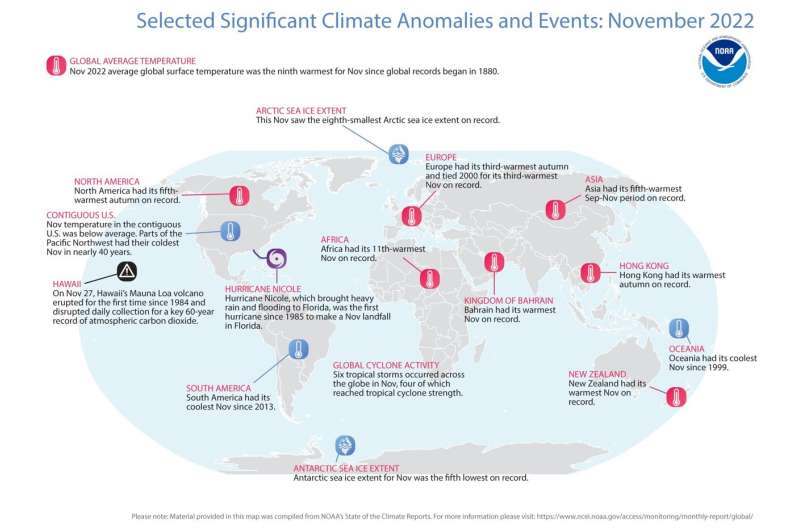A map of the world plotted with some of the most significant climate events that occurred during November 2022. Credit: NOAA NCEI
Last month was another unusually warm month, as the planet saw its ninth-warmest November on record.
Looking at the Arctic and Antarctic, both poles had their top-10 lowest November sea ice coverage on record.
Below are more highlights from NOAA's November global climate report:
November 2022
The average global land and ocean surface temperature for November 2022 was 1.37 degrees F (0.76 of a degree C) above the 20th-century average. This ranks as the ninth-warmest November in 143 years, but the coolest November since 2014.
November 2022 marked the 46th consecutive November and the 455th consecutive month with temperatures above the 20th-century average.
Europe tied 2000 for its third-warmest November on record. South America, Asia and Africa each had a November that ranked among their 20 warmest on record. North America had a warmer-than-average November, but it did not rank among its top-20 warmest.
Season (September through November) and year to date
The season (meteorological spring or autumn, depending on the hemisphere) saw an average global land and ocean temperature of 1.51 degrees F (0.84 of a degree C) above the average of 57.1 degrees F (14 degrees C). This ties with September through November of 2016 and 2018 as the fifth-warmest such season in the climate record.
The year to date (YTD, January through November) global land and ocean surface temperature was 1.55 degrees F (0.86 of a degree C) above the 20th-century average, making it the sixth-warmest YTD on record.
According to NCEI's Global Annual Temperature Rankings Outlook, there is a greater than 99% chance that 2022 will rank among the 10-warmest years on record but a less than 1% chance that it will rank among the top five.
Other notable climate events
- Polar sea ice coverage was among the top-five lowest: Globally, November 2022 saw the fourth-lowest November sea ice extent (coverage) on record. Arctic sea ice extent in November averaged 3.75 million square miles, which is about 165,000 square miles below the 1991–2020 average. This marks the eighth-smallest November extent in the 44-year record. The Antarctic sea ice extent ranked fifth smallest on record at 5.81 million square miles, or about 313,000 square miles below the 1991–2020 average.
- Six named tropical storms formed in November: Of those six, four reached tropical cyclone strength (74 mph winds or higher), but none reached major tropical cyclone strength (111 mph winds or higher). The North Atlantic, with three hurricanes, was more active than normal during November. The West Pacific had below average activity for the month with two named storms, including one typhoon. No storms were active in the East Pacific during November for the first time since 2017.
More information: Access NOAA's latest climate report
Provided by NOAA Headquarters
























